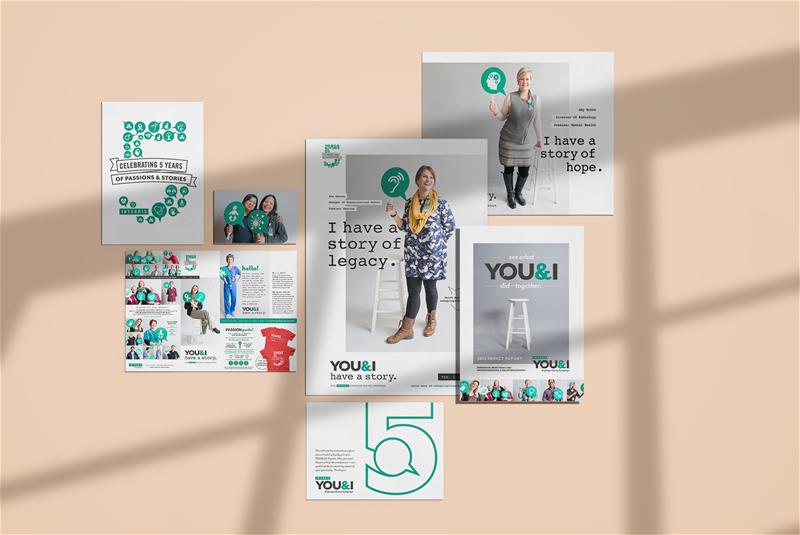Think Differently about Brand to Elevate Employee Giving
Jenny Love
Published: 03/02/2020

Materials from INTEGRIS Foundation's You and I employee giving campaign. Image source: https://www.weareforgood.com/
In the first article of our three-part series on marketing hacks to transform your employee giving campaign, we explored the role of ethos in campaign design. Today, Jon McCoy and Becky Endicott, respectively the director of annual giving and the leadership gifts officer at INTEGRIS Foundation, talk about creating a brand that brings employees closer to each other and encourages them to give back to their organization.
Brand ≠ Logo
When you think of an organization’s brand, you might imagine the Nike swoosh or the Amazon smile. But defining your brand by its logo and colors can cause you to miss out on a lot of opportunities.
“Brand is bigger than just your logo. It’s the sum of experiences people have with your foundation and feelings they have about it,” Jon said. “It’s not what you say about you. It’s about what others say about you.”
Branding is about shaping those messages and experiences. Some of that is done through your foundation’s visual identity, for sure, but much of it comes from the interactions donors and employees have with you. To change your brand, you need to think about how you can change people’s impression of you.
Connect Your Employees to Your Brand
Jon and Becky suggest that you stop thinking about how you can tell your brand story. Instead, think about how you can help your employees tell their stories. Your brand should make your employees feel connected to the impact your organization is having on your community.
“People want their story to be heard,” Jon said. “At the end of the day, they are the center of their own world. If employees can use their gift to honor their mother, who had cancer, or whatever it might be, it builds dedication to the cause.”
The employee giving campaign at INTEGRIS—called You&I, where the “I” stands for INTEGRIS—encourages employees to give to a project that is meaningful to them. Every year, Jon and Becky choose “passion projects”' in 20 different areas, such as transplant or mental health. Projects are specific: employees don’t just give to “transplant;” they choose to donate to house a transplant family every day for the whole year.
“These projects are close to home,” said Jon. “As in, down the hall from where a lot of our employees are working.”
Choosing tangible projects means that employees can literally see the impact their donations are having, whether it be a new playground being built or a piece of equipment in rotation at the hospital. The foundation team affixes stickers to items purchased through the employee giving program to remind employees where their money is going. All projects are designed to show a tangible impact within that year, so the foundation team can point to the impact the next year when they ask employees to give again.
Use Visual Identity to Reinforce Your Brand
The visual components of your brand—your colors, fonts, imagery, and style—should reflect your campaign messages. For Jon and Becky, this meant ditching the corporate-speak, humanizing their stories, and not using any stock photography.
“Using real people, who other people in the organization would recognize, is yet another opportunity to make people feel connected to the campaign,” said Becky.
Getting shots of your employees doesn’t have to be complicated or expensive. Jon and Becky set up a photo booth to photograph staff for less than $100 using materials purchased on Amazon and at Walmart. They designed cardboard “passion icons” on sticks for each of their projects, set up their photo booth in a high-traffic area, and invited passing employees to have their photo taken holding the icon of their choice. They used the photos in marketing materials for the campaign and in their annual impact report.
The passion icons became the hallmark symbols of their campaign, appearing in photos and video, on badge reels, and in email signatures sent to people who had donated.
“When building a visual brand, it pays off to build something iconic,” Jon said. “We wanted something that is easy to recognize and understand.” The passion icons were the answer.
Encourage Viral Branding
Another goal of the passion icons was to build curiosity. “We wanted people to ask about the logos when they saw them: what is it? What is it connected to?” Becky said. “There are only 10 people in our foundation out of 10,000 employees. We needed to engage with volunteers to get feet on the street.”
To build curiosity and encourage the campaign to go viral among employees, Becky and Jon put the passion symbols on stewardship gifts, with the intention of making them a point of pride. They also engaged employees to write and deliver hand-written thank-you notes.
Ultimately, though, INTEGRIS’ success comes back to the personal connection with the brand. “We get so much positive feedback from people who are able to talk about their own story,” Jon said. “If you only have a general giving campaign, it would be a lot harder to do that.